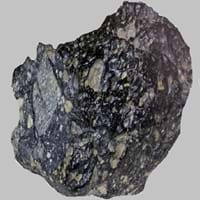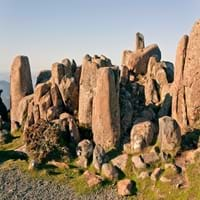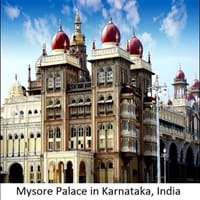Granite is a very hard, granular, crystalline igneous rock which consists mainly of quartz, mica, and feldspar and is often used as building stone 0
From Italian granito, which means grained rock, from grano grain, and from Latin granum 0
Durable Rock, Hard Rock 0
Coarse Grained Rock, Opaque Rock 0
Black, Grey, Orange, Pink, White 0
Countertops, Decorative Aggregates, Entryways, Floor Tiles, Flooring, Homes, Hotels, Interior Decoration, Kitchens, Stair Treads 0
As Building Stone, As Facing Stone, Bridges, Paving Stone, Garden Decoration, Near Swimming Pools, Office Buildings, Resorts 0
Monuments, Sculpture, Small Figurines 0
Curling, Gemstone, Laboratory bench tops, Tombstones, Used in aquariums 0
Igneous Protolith Granite, Sedimentary Protolith Granite, Mantle Granite, Anorogenic Granite, Hybrid Granite, Granodiorite and Alkali Feldspar Granite 0
Available in Lots of Colors and Patterns, It is One of the Oldest, Strongest and Hardest Rock 0
Archaeological Significance
0
Agia Sophia in Istanbul, Turkey, Blue Domed Church in Santorini, Greece, Blue Mosque in Istanbul, Charminar in Hyderabad, India, Diana, Princess of Wales Memorial Fountain in London, UK, Ephesus in Turkey, Georgia Guidestones in Georgia, US, Hermitage in Saint Petersburg, Khajuraho Temples, India, Mahabalipuram in Tamil Nadu, India, Mysore Palace in Karnataka, India, Signers Monument in Augusta, Georgia, Statue of Liberty in New York, USA, Taj Mahal in Agra, India, Tower Bridge in London, Vietnam Veterans Memorial in Washington, US, Washington Monument, US 0
Avukana Buddha Statue in Sri Lanka, Lincoln Memorial in America, Mount Rushmore National Memorial in South Dakota, US, The Colossal Red Granite Statue of Amenhotep III in Karnak, Egypt 0
Granite is an intrusive igneous rock which is very hard, crystalline and is visibly homogeneous in texture and forms by melting of continental rocks 0
Amphibole, Biotite, Feldspar, Hornblade, Micas, Muscovite or Illite, Plagioclase, Pyroxene, Quartz 0
Aluminium Oxide, CaO, Iron(III) Oxide, FeO, Potassium Oxide, MgO, MnO, Sodium Oxide, Phosphorus Pentoxide, Silicon Dioxide, Titanium Dioxide 0
Burial Metamorphism, Cataclastic Metamorphism 0
Chemical Erosion, Sea Erosion, Water Erosion 0
Large and Coarse Grained 0
Dull to Grainy with Sporadic parts Pearly and Vitreous 0
Heat Resistant, Wear Resistant 0
Deposits in Eastern Continents
0
China, India, Iran, Saudi Arabia, Sri Lanka, Taiwan, Thailand, Turkey, Vietnam 0
Angola, Egypt, Madagascar, Namibia, Nigeria, South Africa 0
Austria, Belgium, Finland, France, Germany, Italy, Norway, Sardinia, Spain, Switzerland, The Czech Republic, Venezuela 0
Deposits in Western Continents
0
Deposits in Oceania Continent
0
Learn more about Properties of Granite
What is Granite? In this section, we will learn more about properties of Granite i.e. physical and thermal properties. Physical properties of Granite include Color, Streak, Hardness, Structure, Cleavage, Fracture, Luster, Specific Gravity etc. The strength of Granite is 175.00 N/mm2. Streak of Granite is white while its cleavage is not available. Luster of Granite is dull to grainy with sporadic parts pearly and vitreous and its fracture is not available. Granite is opaque in nature. Know all about Granite, What is Granite, its composition, features, facts and reserves in next sections.
Know about Composition of Granite
What is Granite composed of? Get to know about composition of Granite here. Granite definition gives information about the Formation of Granite and its composition.The composition of Granite can be further divided into mineral and compound content. The mineral content of Granite rock includes Amphibole, Biotite, Feldspar, Hornblade, Micas, Muscovite or Illite, Plagioclase, Pyroxene, Quartz and The compound content of Granite rock includes Aluminium Oxide, CaO, Iron(III) Oxide, FeO, Potassium Oxide, MgO, MnO, Sodium Oxide, Phosphorus Pentoxide, Silicon Dioxide, Titanium Dioxide. Almost all rocks undergo transformation process. Know all about Granite rock in next section.












